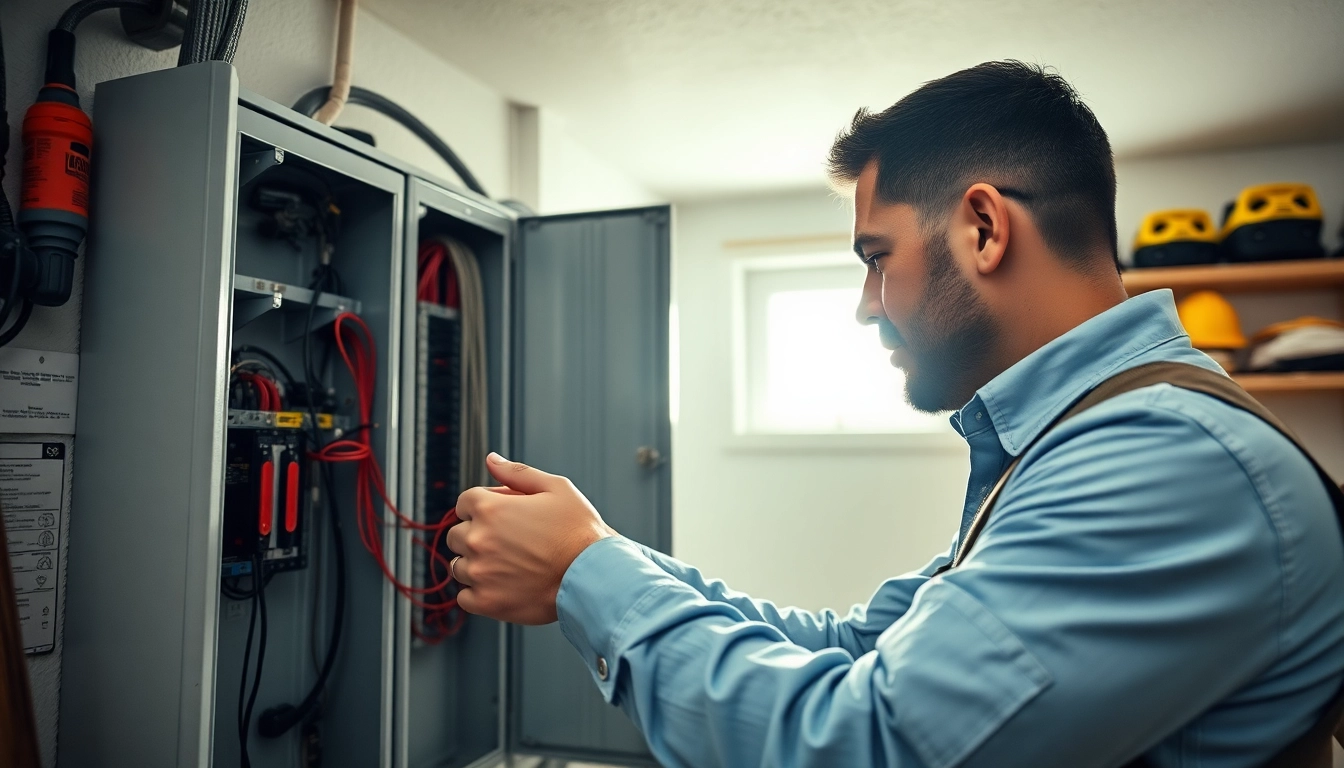Understanding Electrical Panel Upgrades
Electrical panels are the heart of your home’s electrical system, distributing power to all your devices, appliances, and outlets. Over time, the demand for electrical power in homes has continuously increased, making older electrical panels inadequate for modern usage. An Electrical Panel Upgrade is an essential step for homeowners facing challenges such as flickering lights, tripped breakers, or outdated systems. This article explores the need for these upgrades, the benefits, costs, and various incentives available to homeowners.
What is an Electrical Panel Upgrade?
An electrical panel upgrade involves replacing your existing panel with a new one that can handle greater electrical loads. This upgrade typically includes increasing the amperage of the panel, which allows for more circuits and higher capacity for power usage throughout the household. Homeowners often upgrade from a 100-amp to a 200-amp panel to accommodate modern appliances, home offices, electric vehicles, and smart home technologies.
Signs You Need an Electrical Panel Upgrade
Recognizing the need for an electrical panel upgrade can prevent hazards and ensure your home’s electrical system runs efficiently. Here are some telling signs:
- Frequent Circuit Breaker Trips: If breakers in your panel are constantly tripping, this indicates that the panel may be overloaded.
- Flickering or Dimming Lights: Inconsistent lighting can suggest that your panel is struggling to deliver power evenly.
- Old or Outdated Equipment: Panels over 20 years old often lack the capacity to handle higher electrical demands.
- Burning Smell or Discoloration: These are serious indicators of overheating and potential failures in the electrical system.
- Inability to Add Circuits: If you find that you need more outlets but your current panel has no room for additional circuits, it’s time to consider an upgrade.
Benefits of an Electrical Panel Upgrade
Upgrading your electrical panel not only enhances safety but also improves the functionality of your home:
- Increased Capacity: A higher amperage panel supports higher electrical loads, catering to new appliances and technologies.
- Improved Safety: Modern panels are designed with better safety features to reduce the risk of electrical fires.
- Enhanced Performance: With a new panel, you’ll experience fewer outages, less flickering, and more reliable power supply.
- Higher Property Value: Potential buyers are often attracted to homes that have upgraded electrical systems, making upgrades a wise investment.
- Future-Proofing: Preparing for advanced technology such as renewable energy systems, EV charging stations, and more outlets for smart devices.
Comparing Electrical Panel Sizes
Common Electrical Panel Sizes Explained
Electrical panels come in various sizes typically rated in amperage. The most common residential panel sizes include:
- 100-Amp Panel: Sufficient for smaller homes with limited electrical demands, often found in older homes.
- 200-Amp Panel: Most common in modern homes, suitable for larger families and more significant energy demands.
- 400-Amp Panel: Generally used in luxury homes or where significant electrical load is anticipated, like electric heating systems or extensive home entertainment systems.
Choosing the Right Amperage for Your Needs
The necessity for a particular amperage primarily depends on household size, appliances, and lifestyle:
- 1-2 Bedrooms: A 100-amp panel may suffice for smaller households with minimal electronic devices.
- 3-4 Bedrooms: A 200-amp panel is ideal, especially for families with multiple electric appliances, computers, and entertainment devices.
- 5+ Bedrooms: For larger homes or those with extensive power needs (e.g., home offices, multiple electrified rooms), consider a 400-amp panel.
Upgrading from 100A to 200A: Is It Necessary?
If your home currently operates on a 100-amp system and you’re encountering issues such as flickering lights or circuit overloads, upgrading to a 200-amp panel may be essential. Moreover, the increasing prevalence of high-power appliances like HVAC systems, tankless water heaters, and electric vehicles necessitates a larger capacity to prevent overload and ensure safety.
The Upgrade Process: What to Expect
Steps Involved in an Electrical Panel Upgrade
Understanding the upgrade process will help you set expectations for timeline and cost:
- Consultation: Contact a licensed electrician to assess your current panel and determine necessary upgrades.
- Permitting: Your electrician will pull the necessary permits from local authorities, as required.
- Installation: The upgrade process begins with shutting off power, removing the old panel, and installing the new one.
- Inspection: Following installation, a local authority will conduct an inspection to ensure everything meets safety codes.
- Power Restoration: Once cleared by the inspector, power is restored, and new connections verified.
Licensing and Permits for Electrical Panel Upgrades
It’s crucial to hire a licensed electrician to ensure compliance with local electrical codes. Electrical work, especially concerning panels, requires reliable permits to guarantee safety. Homeowners should not attempt panel upgrades themselves due to the potential danger of electrical hazards and the complexity of the work.
Choosing the Right Electrician for Your Upgrade
Choosing a qualified electrician is vital for ensuring that your electrical panel upgrade is conducted safely and effectively. Consider the following tips:
- Check Credentials: Verify they are licensed, insured, and experienced in panel upgrades.
- Ask for References: A reputable electrician should provide previous client references.
- Get Multiple Quotes: Compare estimates from several electricians to gauge average costs and services offered.
- Review Reviews: Look for reviews on platforms like Google, Yelp, or Angie’s List.
Cost Analysis of Electrical Panel Upgrades
Average Costs of Different Panel Upgrades
The cost to upgrade an electrical panel varies significantly based on several factors. On average, homeowners should expect to pay between $800 and $4,000 for panel upgrades, with most common upgrades from 100 to 200 amps averaging around $1,300 to $3,000.
Factors affecting the cost can include:
- Type of New Panel: The cost of panels ranges based on features, brands, and specifications.
- Labor Costs: The skill level and hourly rate of your electrician will influence total costs.
- Additional Work Needed: If new wiring or circuit additions are required, expect additional charges.
Factors Affecting the Cost of Electrical Upgrades
When budgeting for an electrical panel upgrade, consider these influencing factors:
- Location: Labor rates vary by region; urban areas typically have higher costs.
- Panel Location: The more accessible your panel is, the lower the labor costs.
- Building Code Requirements: Local code requirements may dictate additional expenses for compliance.
Understanding Your Return on Investment (ROI)
While the upfront costs may seem significant, an electrical panel upgrade can enhance the overall value of your home. Benefits include lower insurance premiums, increased efficiency, and safety improvements. A modern panel also makes your home more attractive to potential buyers, yielding favorable returns on your investment when you decide to sell.
Incentives and Rebates for Electrical Panel Upgrades
Current Government Rebate Programs
Many homeowners may not realize that there are government programs aimed at subsidizing the costs associated with upgrading electrical panels, especially those that improve energy efficiency or support electric vehicle charging. Research local and federal rebate programs that may apply to your situation.
Tax Credits Available for Electrical Upgrades
In addition to rebates, tax credits are available which can provide significant savings. Programs like ENERGY STAR often include provisions for upgrades that support additional features, such as solar power or advanced heating systems, enhancing the value of your upgrade.
Financial Assistance Options for Homeowners
Some utility companies and government entities offer low-interest loans or financing options for electrical upgrades. Investigating these options can provide essential financial support to facilitate any needed electrical updates without overwhelming your budget.


